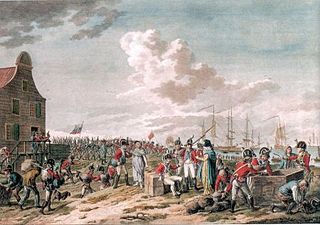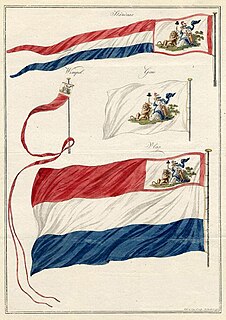 W
WThe Anglo-Russian invasion of Holland was a military campaign from 27 August to 19 November 1799 during the War of the Second Coalition, in which an expeditionary force of British and Russian troops invaded the North Holland peninsula in the Batavian Republic. The campaign had two strategic objectives: to neutralize the Batavian fleet and to promote an uprising by followers of the former stadtholder William V against the Batavian government. The invasion was opposed by a slightly smaller joint Franco-Batavian army. Tactically, the Anglo-Russian forces were successful initially, defeating the defenders in the battles of Callantsoog and the Krabbendam, but subsequent battles went against the Anglo-Russian forces. Following a defeat at Castricum, the Duke of York, the British supreme commander, decided upon a strategic retreat to the original bridgehead in the extreme north of the peninsula. Subsequently, an agreement was negotiated with the supreme commander of the Franco-Batavian forces, General Guillaume Marie Anne Brune, that allowed the Anglo-Russian forces to evacuate this bridgehead unmolested. However, the expedition partly succeeded in its first objective, capturing a significant proportion of the Batavian fleet.
 W
WThe Batavian navy was the navy of the Batavian Republic. A continuation of the Staatse vloot of the Dutch Republic, though thoroughly reorganized after the Batavian Revolution of 1795, the navy embarked on several naval construction programs which, at least on paper, made her a serious rival of the Royal Navy during War of the Second Coalition. However, the Capitulation of Saldanha Bay, the Battle of Camperdown and the Vlieter Incident showed that she did not measure up to that expectation. Nevertheless, the organisational reorganizations proved durable, when the Batavian Republic was succeeded by the Kingdom of Holland, and later, the Kingdom of the Netherlands, so that the present-day Royal Netherlands Navy should trace its ancestry through her.
 W
WThe Battle of Camperdown was a major naval action fought on 11 October 1797, between the British North Sea Fleet under Admiral Adam Duncan and a Batavian Navy (Dutch) fleet under Vice-Admiral Jan de Winter. The battle was the most significant action between British and Dutch forces during the French Revolutionary Wars and resulted in a complete victory for the British, who captured eleven Dutch ships without losing any of their own. In 1795, the Dutch Republic had been overrun by the army of the French Republic and had been reorganised into the Batavian Republic, a French client state. In early 1797, after the French Atlantic Fleet had suffered heavy losses in a disastrous winter campaign, the Dutch fleet was ordered to reinforce the French at Brest. The rendezvous never occurred; the continental allies failed to capitalise on the Spithead and Nore mutinies that paralysed the British Channel forces and North Sea fleets during the spring of 1797.
 W
WNapoleon's planned invasion of the United Kingdom at the start of the War of the Third Coalition, although never carried out, was a major influence on British naval strategy and the fortification of the coast of southeast England. French attempts to invade Ireland in order to destabilise the United Kingdom or as a stepping-stone to Great Britain had already occurred in 1796. The first French Army of England had gathered on the Channel coast in 1798, but an invasion of England was sidelined by Napoleon's concentration on campaigns in Egypt and against Austria, and shelved in 1802 by the Peace of Amiens. Building on planning for mooted invasions under France's Ancien Régime in 1744, 1759 and 1779, preparations began again in earnest soon after the outbreak of war in 1803, and were finally called off in 1805. Contrary to popular belief, the invasion was called off before the Battle of Trafalgar.
 W
WThe Capitulation of Saldanha Bay was the surrender in 1796 to the British Royal Navy of a Dutch expeditionary force sent to recapture the Dutch Cape Colony. In 1794, early in the French Revolutionary Wars, the army of the French Republic overran the Dutch Republic which then became a French client state, the Batavian Republic. Great Britain was concerned by the threat the Dutch Cape Colony in Southern Africa posed to its trade routes to British India. It therefore sent an expeditionary force that landed at Simon's Town in June 1795 and forced the surrender of the colony in a short campaign. The British commander, Vice-Admiral Sir George Elphinstone, then reinforced the garrison and stationed a naval squadron at the Cape to protect the captured colony.
 W
WIn the Vlieter incident on 30 August 1799, a squadron of the Batavian Navy, commanded by Rear-Admiral Samuel Story, surrendered to the British navy. The incident occurred during the Anglo-Russian invasion of Holland. It occurred in the tidal trench between Texel and the mainland that was known as De Vlieter, near Wieringen.
 W
WJan Willem de Winter was a Dutch admiral during the Napoleonic Wars.